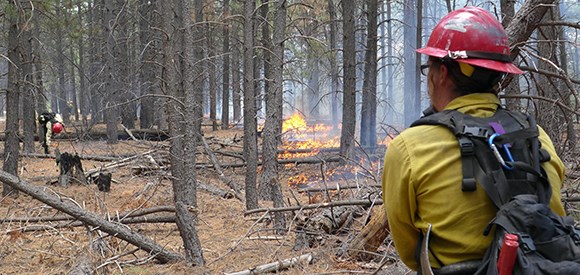Last updated: December 15, 2017
Article
Wildland Fire: Right Response, Right Time, Right Reasons

NPS / Jason Thivener
All fires are different. Fire managers evaluate each one and determine the safest, most effective, and cost-efficient strategies to manage it.
When the lightning-ignited Deer Head fire started on July 24, 2014, park fire managers decided to manage the fire to maintain a healthy forest and wildlife habitat. The fire was located between 7,000 and 8,400 feet in the fire-adapted woodlands and forests of Saguaro National Park’s Rincon Mountains. Vegetation in the area includes ponderosa pine, oak, and brush. Parts of the area had burned nine times since 1937.
Firefighters used strategic burnout operations to help protect and direct the fire’s spread away from sensitive resources, including the historic Manning Camp, and to keep the fire in an area where they could safely manage it. Fire managers worked with state officials to monitor and manage smoke impacts.
The fire was within the Saguaro Wilderness, and fire management activities were conducted with a light hand on the land approach to protect wilderness values and minimize erosion and disturbance to sensitive species, as well as to protect watershed and riparian areas. Minimum impact tactics were used whenever possible, including using existing trails and rock outcroppings as firelines. Firefighters removed standing trees only if they posed a safety hazard. They cut stumps flush to the ground and scattered cut branches and logs to help make the area look as natural as possible. Mules were used to help pack gear to and from the base camp. Although firefighters were flown in to provide a timely initial response, they hiked out over nine miles to help minimize the use of helicopters. A gradual increase in monsoon moisture eventually extinguished the fire naturally. It was contained at 1,097 acres on August 15.
In contrast, when the lightning-ignited Jackalope fire started on July 31, 2014, fire managers fully suppressed it. The fire was burning in grass and juniper at an elevation of about 5,700 feet. No structures were threatened, but the fire had the potential to threaten fire-sensitive Sonoran Desert vegetation nearby. The fire was located approximately 0.1 mile from patches of buffelgrass, an invasive species that creates a heavy, continuous fuel load and can easily spread intense wildfire and lead to rapid postfire erosion. If the fire had reached the buffelgrass, it could have carried fire downslope, threatening desert vegetation, including saguaro and other cacti and palo verde, and wildlife such as desert tortoise that cannot withstand fire. Additionally, restoring native vegetation in areas where fire-adapted buffelgrass has burned is extremely difficult.
Firefighters were flown in by helicopter to begin suppressing the Jackalope fire on the afternoon it was reported. A helicopter also dropped water from a bucket to help suppress the fire. It was contained at 30 acres on August 2, 2014, without reaching buffelgrass.
Learn more about Saguaro National Park’s fire management program.
Contact: John Thornburg, fire management officer
Email: e-mail us
Phone: (520) 733-5130
